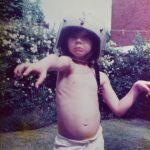JAMES MURRAY – CAREFUL NOW
The cover shows a photo of the artist as a five-year-old, wearing a motorcycle helmet. From his expression, it’s not sure if he is playing or maybe feared. The album title is Careful Now. What is James Murray trying to tell us about this release?
We’ll probably have to guess because he’s not telling us any details:
“I’ve been more upfront in the past but not this time so much… letting listeners arrive at the album without too many preconceptions. Let’s just say it reflects some of where I’ve been at mentally and emotionally these past few years in a bunch of different ways.”
James Murray‘s music always feels very personal. It’s hard to explain why that is because it’s instrumental and fairly abstract ambient music. It must have something to do with the sound design he chooses, the careful construction of the palette, and the hints of melodies that can be felt on an almost subconscious level.
Careful Now is James Murray‘s first solo album since 2019. This time it is not released on his own Slowcraft label, but on Ian Hawgood’s Home Normal, a fitting home that also released some of his earlier albums Killing Ghosts and Falling Backwards), as well as some collaborations.
The six compositions on this album confirm the reputation that Murray already has. I guess he even sets a new standard for himself: it is an overwhelmingly deep sound with many detailed levels, at times with a thundering sub-low: “Deep rumbling bass elements burst open like flood gates into huge synth drone driven melodies and textures fizzing and skittering over the surface of all the depth that continues to resonate below.”
Listening on a good system is advised here: it gave me the sensation as if I was listening to a surround mix, completely immersive.
The emotions are up to the listener to decide: within one track, one can hear impending doom, or joy, or melancholic nostalgia – depending on your own personal state of mind. everything is in the ear of the beholder.
Not many artists can do that like James Murray can.
DAVID CORDERO & KENJI KIHARA – KOMOREBI 木漏れ日 
The Japanese word komorebi expresses something like “sunlight filtered by leaves”. And that is a great description of the music on this album which is as bright as its cover image.
It is perfect music for the Spring season: it was released in June this year, and marked the return of the Home Normal label after a short hiatus.
David and Kenji met in 2018 when they both performed in Tokyo. Out of mutual admiration, they decided to collaborate on a new album. This collaboration links Tokyo, Japan (Kenji Kihara, perhaps also known as Sphontik) to Cádiz, Spain (David Cordero).
It is not clear who exactly plays what, but the two artists managed to create ‘an album of subtle electronics within an ambient framework that beautifully draws in the light between the spring and summer seasons’.
Which definitely is a welcome change among all the darker ambient albums of late.
MODULAR SLEEP PATTERNS – MODULAR SLEEP PATTERNS 
I guess a title like that triggers many lovers of ambient music. Ian Hawgood and Stijn Hüwels have previously recorded together: No Voices in 2019, Day Falls (with James Murray) and Voices in 2021), but this is their first release as Modular Sleep Patterns.
For these 10 ‘patterns’, Hawgood and Hüwels developed worked out a new compositional process: ‘processing loops from an OP-1 synth through a Ciat Lonbarde modular set-up and recording straight onto old tape we needed to use up before it snapped due to age and decay. Using vocals and synths going into the simple OP-1 sampler engine, the (slightly uncontrollable) reels would create pitch-shifting patterns of deep drone music which we layered with guitars.’
Due to the state of the old reels, this work can never be recovered again – but luckily it is caught and released on CD (/digital).
The sound is quiet, subdued, with all the characteristics of all things analog (and old). The music is clearly intended to ‘help you find these patterns a gentle persuasion to sleep and/or rest easy.’
For that purpose, the 10 separate tracks can best be enjoyed in one uninterrupted session.






